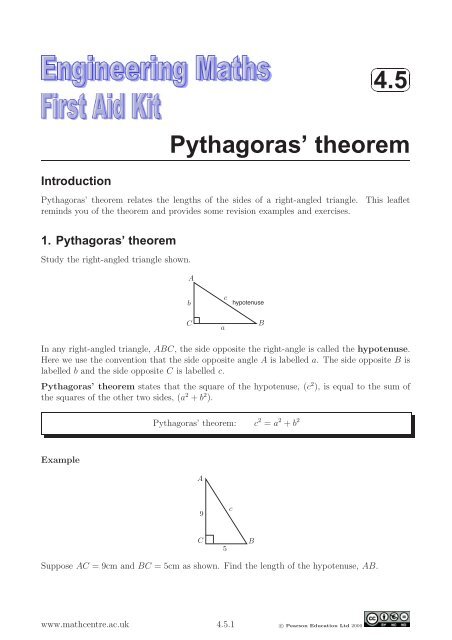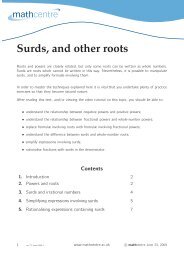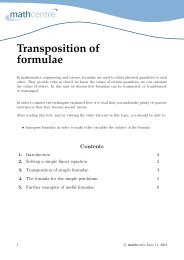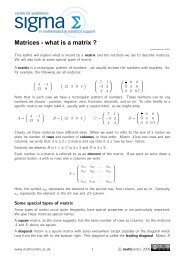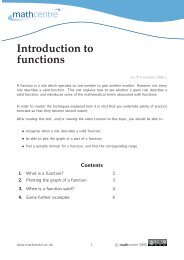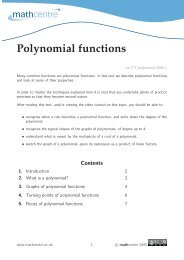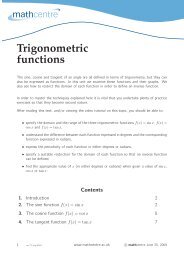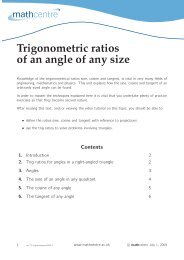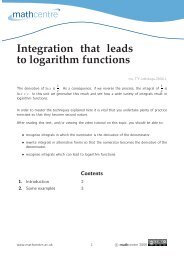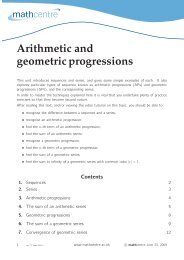4.5 Pythagoras' theorem - Mathcentre
4.5 Pythagoras' theorem - Mathcentre
4.5 Pythagoras' theorem - Mathcentre
You also want an ePaper? Increase the reach of your titles
YUMPU automatically turns print PDFs into web optimized ePapers that Google loves.
Introduction<br />
<strong>4.5</strong><br />
✎<br />
✍<br />
Pythagoras’ <strong>theorem</strong><br />
Pythagoras’ <strong>theorem</strong> relates the lengths of the sides of a right-angled triangle. This leaflet<br />
reminds you of the <strong>theorem</strong> and provides some revision examples and exercises.<br />
1. Pythagoras’ <strong>theorem</strong><br />
Study the right-angled triangle shown.<br />
A<br />
b<br />
C<br />
a<br />
c<br />
hypotenuse<br />
In any right-angled triangle, ABC, the side opposite the right-angle is called the hypotenuse.<br />
Here we use the convention that the side opposite angle A is labelled a. The side opposite B is<br />
labelled b and the side opposite C is labelled c.<br />
Pythagoras’ <strong>theorem</strong> states that the square of the hypotenuse, (c 2 ), is equal to the sum of<br />
the squares of the other two sides, (a 2 + b 2 ).<br />
Example<br />
Pythagoras’ <strong>theorem</strong>: c 2 = a 2 + b 2<br />
A<br />
9<br />
C<br />
Suppose AC = 9cm and BC = 5cm as shown. Find the length of the hypotenuse, AB.<br />
www.mathcentre.ac.uk <strong>4.5</strong>.1 c○ Pearson Education Ltd 2000<br />
5<br />
c<br />
B<br />
B<br />
☞<br />
✌
Solution<br />
Here, a = BC = 5, and b = AC = 9. Using the <strong>theorem</strong><br />
c 2 = a 2 + b 2<br />
= 5 2 + 9 2<br />
= 25 + 81<br />
= 106<br />
c = √ 106 = 10.30 (2dp.)<br />
The hypotenuse has length 10.30cm.<br />
Example<br />
In triangle ABC shown, suppose that the length of the hypotenuse is 14cm and that a = BC =<br />
3cm. Find the length of AC.<br />
A<br />
Solution<br />
Here a = BC = 3, and c = AB = 14. Using the <strong>theorem</strong><br />
c 2 = a 2 + b 2<br />
14 2 = 3 2 + b 2<br />
196 = 9 + b 2<br />
b 2 = 196 − 9<br />
= 187<br />
b = √ 187 = 13.67 (2dp.)<br />
The length of AC is 13.67cm.<br />
b<br />
C<br />
Exercises<br />
1. In triangle ABC in which C = 90 ◦ , AB = 25 cm and AC = 17 cm. Find the length BC.<br />
2. In triangle ABC, the angle at B is the right-angle. If AB = BC = 5 cm find AC.<br />
3. In triangle CDE the right-angle is E. If CD = 55cm and DE = 37cm find EC.<br />
Answers<br />
1. 18.33 cm. (2dp.)<br />
2. AC = √ 50 = 7.07 cm. (2dp.)<br />
3. EC = √ 1656 = 40.69 cm. (2dp.)<br />
www.mathcentre.ac.uk <strong>4.5</strong>.2 c○ Pearson Education Ltd 2000<br />
3<br />
14<br />
B


